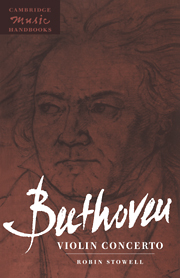Book contents
- Frontmatter
- Contents
- List of figures
- Preface
- 1 Towards the Violin Concerto Op. 61
- 2 The genesis of Op. 61
- 3 Reception and performance history
- 4 The textual history
- 5 Structure and style I – 1. Allegro ma non troppo
- 6 Structure and style II – 2/3. Larghetto – Rondo: Allegro
- 7 Cadenzas
- Appendix 1 Select discography
- Appendix 2 Published cadenzas
- Appendix 3 Textual problems perpetuated in some printed scores
- Notes
- Select bibliography
- Index
5 - Structure and style I – 1. Allegro ma non troppo
Published online by Cambridge University Press: 28 October 2009
- Frontmatter
- Contents
- List of figures
- Preface
- 1 Towards the Violin Concerto Op. 61
- 2 The genesis of Op. 61
- 3 Reception and performance history
- 4 The textual history
- 5 Structure and style I – 1. Allegro ma non troppo
- 6 Structure and style II – 2/3. Larghetto – Rondo: Allegro
- 7 Cadenzas
- Appendix 1 Select discography
- Appendix 2 Published cadenzas
- Appendix 3 Textual problems perpetuated in some printed scores
- Notes
- Select bibliography
- Index
Summary
With his Third Piano Concerto (cl800), Beethoven had begun to free himself from many contemporary conventions in the genre. He had broadened the scope of the first movement to symphonic proportions, combining thematic development with the free fantasia of the French concerto; he had restored and strengthened the principle of equality and opposition between orchestra and soloist; and he had achieved a much greater concentration, integration and economy of thematic material, shared by orchestra and soloist. He built upon these developments in his Violin Concerto. Despite its implied march pulse, the first movement is far removed from the concerto concept of Beethoven's contemporaries, whose thematic and formal freedom is replaced by a more tightly-knit symphonic structure on the largest scale. Greater emphasis is placed on thematic development and structural coherence and less weight on virtuoso display, the soloist appearing at times almost incidental and functioning more as a commentator upon and embellisher of thematic statements and developments made by the orchestra than as a means of developing that material or introducing new themes. As Georges Enesco perceptively remarked: ‘This is a great symphony. The violin has a leading voice, but it is merely one of the many orchestral voices which make up the whole.’
Beethoven's skill and ingenuity in orchestration yield a rich kaleidoscope of orchestral colour, in which the ever-varied contrasts and combinations of solo violin and woodwind have particular significance.
- Type
- Chapter
- Information
- Beethoven: Violin Concerto , pp. 60 - 73Publisher: Cambridge University PressPrint publication year: 1998

